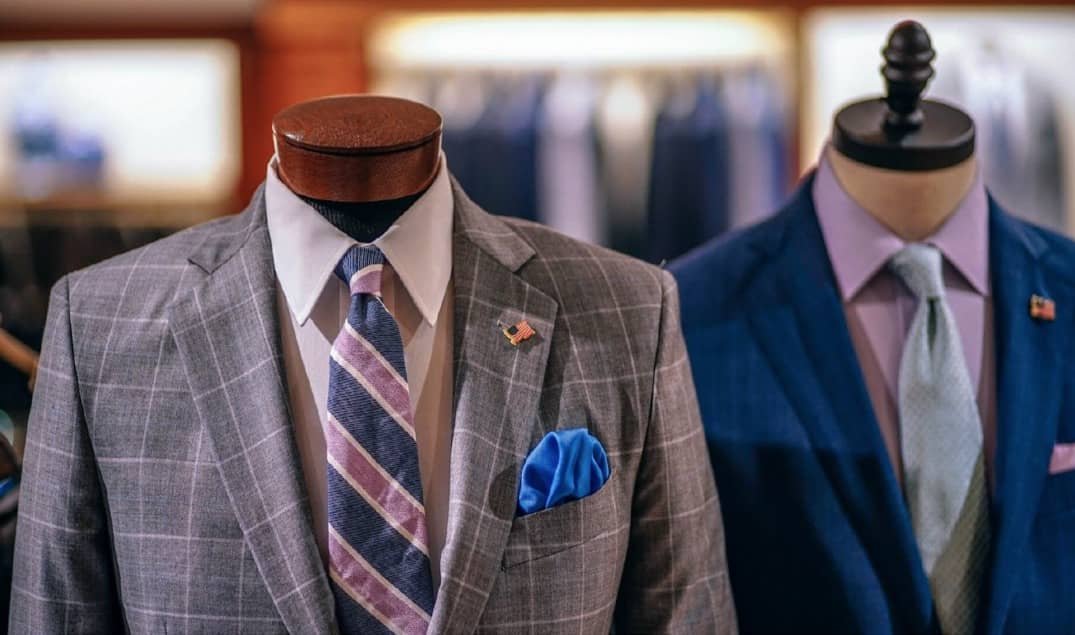
Men’s Clothing Style Guides
So you’re considering buying custom clothing – Congratulations!
A tailored suit, shirt, or coat can be one of the best investments a man makes. Done right, a good piece of tailored clothing will last for years or even decades, fit like a dream, and make the wearer look great. There are, however, pitfalls that even an experienced clothing buyer can stumble into along the way to a great custom outfit.
Mistake #1: The Rush Job
Buying Too Much Too Quickly.
This is going to sound like crazy talk coming from a guy who sells package deals on custom clothing, but here it is: you don’t have to buy the whole wardrobe at once. In fact, you basically can’t buy an entire wardrobe at once, not and expect it to all go well together and fit you well.
The biggest mistake, the number one error a guy can make, when he decides “yes, I’m going to take the plunge; I am going to be a custom clothing man from here on” is to run right out and order half a dozen suits and a dozen shirts from the same tailor. There are a couple reasons this is a bad idea: number one, it’s letting your tastes at a single moment in time shape the bulk of your wardrobe. Tastes change and sensibilities develop over time.
You don’t want to sink a big pile of money into one look, and then realize a year later that you hate wearing the bulk of your clothing options.
The number two reason to avoid this mistake is that it frontloads your tailor with the bulk of the work he’s ever going to do for you at the time when he’s least familiar with your measurements and your personal tastes. Start with a few pieces and give your tailor detailed feedback on what you like and don’t like about those before ordering more clothing.
The finished product will be that much better for it. None of that is to say you should avoid package deals. A suit and a couple of shirts, maybe even two or three suits and an overcoat and a handful of shirts? That’s fine for a starting place.
It’s a good balance between giving your tastes and your relationship with your tailor time to develop, but also having a decent variety of sharp, custom-tailored looks available right out of the starting gate. But if you had any thoughts of throwing everything out and starting all over with an entirely hand-tailored wardrobe bought all at once, think again.
It’s not the way to do it, even for the lucky few that could afford a whole new custom tailored wardrobe cash on the barrel.
Mistake #2: Lost in the Woods | Men’s Clothing Style Guides
Not Understanding the Custom Process
While we’re on the subject of cash, it’s worth having a decent idea what you’re getting into in terms of the process and the costs of custom-tailoring.
Individual prices are going to vary widely depending on the skill of the tailor, the level of customization, local economic conditions, and (often more than any other factor) the cost of the raw cloth used.
Custom tailoring can be broadly broken down into two categories: 1. Made To Measure 2. Bespoke
Made to measure tailoring uses an existing pattern adjusted to an individual’s measurements. Other than changing the measurements, and sometimes offering a selection of cloths, the tailor is essentially making the same garment over and over again. That reduces effort – and cost – but also limits the customization, and typically only adjusts the fit to a half-dozen to a dozen measurements.
Bespoke tailoring is customized from scratch. The tailor may build most of his garments along the same lines, of course, but the details of the garment are individually tailored, and the tailor will likely use dozens or even hundreds of physical measurement to determine the size and proportion of the garment.
While it’s not a given, bespoke tailors also typically offer a wider selection of fabrics and materials, all the way down to the suit lining or the button threads. Unsurprisingly, bespoke tailoring is substantially more expensive than made to measure. A bespoke garment also requires more input from the customer, and will take longer to complete. (Any traveling “overnight custom shirts/suits/etc.” operation will almost certainly be made to measure – there isn’t time for a true bespoke experience in a hotel lobby).
If you’re new to custom tailoring, made to measure isn’t a bad starting place. The result is still going to be customized for you, giving a much better look and fit than even an adjusted off the rack garment. For the best visual and physical results, bespoke will always be the way to go, but the buyer should come prepared with a firm idea of exactly what he wants, and an understanding that the process will involve multiple measurements, plenty of input from both tailor and customer, lengthy production times, and of course a higher price tag.
Mistake #3: Getting Fancy | Men’s Clothing Style Guides
Not Buying Simple Classic Styles First.
Customization can get overwhelming – and intoxicating. When you’ve got a skilled professional on board to make you literally anything you want to wear, there’s going to be a temptation to get pretty wild with it. Something that’s worth remembering is that well-made custom clothing lasts. It’s not a short-term investment.

Assuming your body doesn’t change shape too dramatically, you could easily be wearing the same shirt for years; the same suit for decades.
That means you don’t want to get too experimental or trend-driven, unless you’ve got the budget and the inclination to keep buying new custom clothes on a regular basis.
Start out with a couple of timeless classics so that you’ll always have them in the closet, high-quality and fitted just for you. Some good starting pieces for the first-time custom clothing buyer might include:
● 2-3 dress shirts in solids and light patterns, inc. a crisp white shirt
● Charcoal gray or navy blue business suit
● Lighter gray flannel suit for business-casual and social wear
● A navy or camel hair blazer
● Corduroy sports jacket
These are all pieces of menswear that just about anyone can find a use for. They’ve stood the test of time. You won’t necessarily look like you’re setting the latest fashion trend in them, but you’ll always be able to at least look respectable in them. Starting with those timeless classics is good because it guarantees a usable end product your first time through the custom tailoring process.
It’s worth applying this rule not just to styles, but also to fabrics: don’t start off with luxury or exotic fabrics your first time through with a custom-tailored. Stick to simple three-weather wools, cotton shirts, and the like, rather than going straight for the vicuna or the triple-digit ultra-ultra-ultra-fines. Your wardrobe will come out a little less flashy, but much more functional.
Further down the road, if you decide you like your tailor and his work, you can start investing in some more unique pieces or rarer fabrics.
Mistake #4: Giving the Tailor a Pass | Men’s Clothing Style Guides
Not Negotiating or Interviewing.
Once again, this is going to sound crazy coming from a professional tailor, but here it is: don’t settle for the first custom tailor you find!
Shop around a bit. Compare cloth options, clothing styles, customer service, and yes, price – although that last is probably not what you want to base your decision on.
Custom tailoring isn’t retail shopping. You’re essentially commissioning a piece of custom craftsmanship. And in this case, it’s craftsmanship that you’re going to display on your body, so you’ve got extra incentive to get exactly the product you want.
Don’t give your tailor the benefit of the doubt. Look at several, and pitch them all on a garment you might potentially want made. Sound them out on the cut you’re looking for.
Ask what fabrics they have available. Inquire what customizations they make in addition to fit – can you add an extra pocket, for example, or have the button stance moved higher or lower?
Haggle a bit, if you’re planning on dropping serious money.
There’s no harm in pitching a basic order (a simple suit, say), and then suggesting that you might be willing to invest in a spare set of trousers and an additional sports jacket if the tailor throws in a custom shirt or two.
Not every tailor negotiates, but how they react gives you a good sense of how flexible and engaged the tailor is.
Remember that no matter how good a price you find, you’ll still be looking at a serious chunk of money.
Chasing the lowest price isn’t the way to find a custom tailor.
You don’t want to pay “just” £450 for a so-so suit when you could have a perfect suit for £1000.
Yeah, you saved money, but the product you got is only barely worth the money you paid, as opposed to something that would have been well worth what you paid and then some.
It’s worth shopping around for tailors – and shopping critically. Say “no thanks” as often as you need to.
Ideally, you want to find someone who carries fabrics you like, routinely produces pieces in the styles you like, and will be willing to work with you on customization, multiple fittings, and satisfaction guarantees.
That’s a lot to ask of a tailor. Not everyone does. Be sure you do.
This is just the beginning of your style journey? Stay connected for the upcoming articles.
Please note that much of this publication is based on personal experience and anecdotal evidence.
Although the author and publisher have made every reasonable attempt to achieve complete accuracy of the content in this Guide, they assume no responsibility for errors or omissions.
Also, you should use this information as you see fit, and at your own risk.
Your particular situation may not be exactly suited to the examples illustrated here; in fact, it’s likely that they won’t be the same, and you should adjust your use of the information and recommendations accordingly.
Finally, use your head. Nothing in this Guide is intended to replace common sense, legal, medical or other professional advice, and is meant to inform and entertain the reader.
So have fun and learn to dress sharp!








